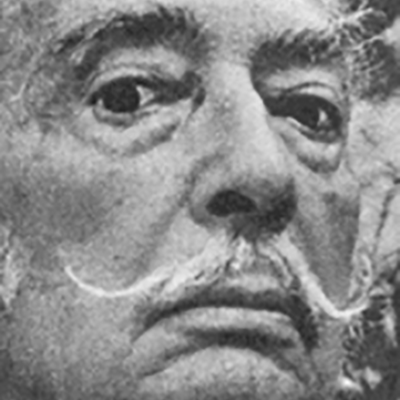Salvador Dalí
(Nou diccionari 62 de la literatura catalana – New Dictionary 62 of Catalan Literature)
Figueres, 1904-1989. Painter, sculptor, decorator and writer. The son of a notary, he studied at the Escuela Superior de Bellas Artes (School of Fine Arts) in Madrid where he lodged at the Students’ Residence and thus came into contact with the group of poets and artists of the Generation of ’27 including Federico García Lorca, with whom he had a peculiar friendship, and Luis Buñuel, with whom he made two films: Un Chien Andalou (1929) and L'Âge d’Or (1930).
He was the leading figure of the surrealist adventure in Catalonia, his work being made known through reviews such as La Publicitat, Hèlix, Mirador, La Revista and L’Amic de les Arts –where he published creative and theoretical texts, the apogee of which was the Manifest groc (Yellow Manifesto, 1928), which was also signed by Lluís Montanyà and Sebastià Gasch, attacking the literature of the day and propounding a series of futurist premises based on mechanisation and sport– and, in particular, thanks to a speech he gave in the Ateneu Barcelonès (Athenaeum of Barcelona) in 1930 in which he synthesised Breton’s ideas and gave an account of his paranoic-critical method.
After this, he moved to Paris where he threw himself into French surrealism, which he would slowly abandon until he definitely closed this chapter in 1950, about the time when he gave another lecture in the Athenaeum, this time announcing his newfound enthusiasm for the spiritual tradition of the great mystics of Spanish literature.
As for his creative work in Catalan, collected in 1995 with the title L’alliberament dels dits (The Liberation of Fingers), it is characterised by an objectivity consisting of his meticulously describing minimal elements –as he does in his painting– and submitting them to continual metamorphoses and absurd action, at once nuanced with arbitrary, bare, yet dense and pungent lyricism.
The Catalan phase, which coincides with the surrealist phase and is homogeneous with the French phase, saw the publication of books such as La femme visible (The Visible Woman, 1930), L'amour et la mémoire (Love and Memory, 1931), La conquête de l'irrationnel (The Conquest of the Irrational, 1935) and La Métamorphose de Narcisse (The Metamorphosis of Narcissus). He also published in French, works in which he delved more deeply into methodological findings: Le Surréalisme au service de la révolution (Surrealism in the Service of Revolution, 1930), Le mithe tragique de l’Angelus de Millet (The Tragic Myth of Millet’s Angelus, which was written in 1932-35 and published in 1963).
Furthermore, he wrote a series of articles and poetic prose pieces in Spanish, some of them for Gaceta literaria and, during his stays in the United States in English, this time an ambitious, cosmopolitan novel set in the Second World War, Hidden Faces (1944), as well as the programmatic autobiography The Secret Life of Salvador Dalí (1942), a veritable confluence of the objective document proper to the genre, literary fabulation and the counterweight of a whole set of artistic beliefs.
Copyright text © 2000 Edicions 62




